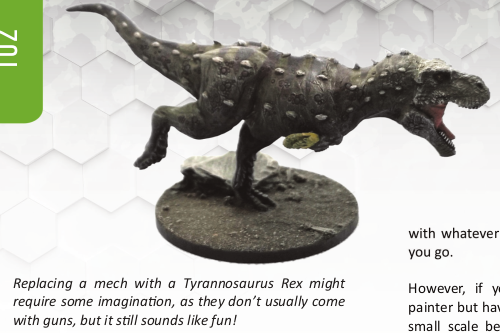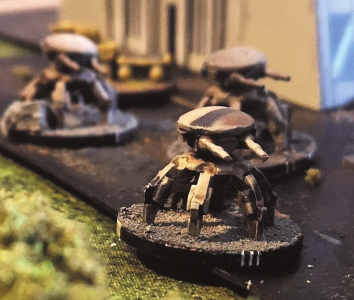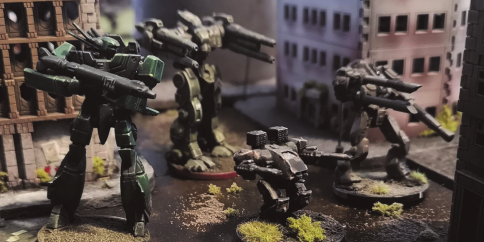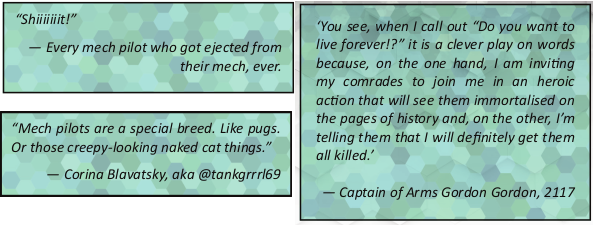
While I haven’t been intently scrounging around for them, I’ve kept my eyes open for any systems that I could use my collection of Dropzone models with, meaning ~10mm scale combined arms with sci-fi flavor. Horizon Wars piqued my interest as it fit those standards, but from discussions I could find concerning it, it was considered a bit bland. Miniature agnostic games do have a far greater risk of that, as you’re relying on the model collection of the player to do the work in providing visual theme and flavor, hoping the rules system can complement a sufficient range of whatever a player might be interested in acting out on the table. That leaves the author having to rely on fiction and rules to convey whatever it is they’re interested in saying and doing. And let’s be honest; the Venn diagram of quality literature and wargame writing are circles on separate pieces of paper, so rules are where you’re going to find the characterization.
Near as I can tell, Horizon Wars didn’t provide you with the customization tools needed to properly flavor your forces and give you that sense of emotional investment, hence the aforementioned criticism of blandness. But, a new version has just released! I’m not sure what ‘Midnight Dark’ actually means in the context of the setting, but regardless, let’s see what Horizon Wars: Midnight Dark has to offer, and if it addresses that and any other shortcomings.
As mentioned, the game is miniature agnostic. There’s a section concerning miniatures which boils down to “just use cool things of around the right size, consistent bases are good, and don’t be a dick about what counts as what”. 40mm bases are mentioned as what the author uses. Movement is from center of base to center of base, and range for all other purposes is edge to edge. Baseless models are measured from physical point to physical point. Naturally, this is going to lead to discussion concerning line of sight and what ‘counts’ as part of the model; line of sight is explained later as the base and ‘everything inside the base’, with things like gun barrels or antenna not being included. Ultimately here, I think you’ll have to fall back on the “don’t be a dick” mindset. I don’t think having to be a bit loose here is unreasonable, as writing a ruleset intended to be played with any collection of miniatures will necessitate some hand waviness.

The game uses d12s and tokens/counters alongside the miniatures, and the missions provided are all played on 2×2, 4×4, or 4×6 areas. It’s welcoming to see that a range of table sizes are explicitly provided in each scenario, as opposed to different scenarios being different sizes. In any case, the dice are used for the main randomization mechanic; tests and counter tests. You’ve got a target number to do something, and you roll some amount of d12s. The roll results are summed, and each multiple of that target counts as a success. For example, if the target is 8, and you roll 17 total, you’ve got two successes with 8+8+1. If you rolled 14 total, only one success, with 8+6. A natural 12 gets you an additional bonus success on top of that.
Counter tests are rolled by the other player, with the goal of canceling out matching dice. An exact match (let’s say they rolled 7, and you roll a 7 as well), takes away that die from their pool, potentially negating successes. Natural 12s here add an automatic success cancel on top of their normal die canceling.
I like the lucky roll/natural 12 mechanic at first glance, since it gives a nice bonus feeling to rolling the largest number, even if otherwise something like a 10 or 11 would result in the same number of successes. Or in the case of countering, the ‘best’ roll might not be what you actually need.

Concerning the flow of the game itself, it’s defined by ‘orders’. Your forces are referred to as a ‘battle group’, which consists of ‘elements’. A small infantry group on a single base or an APC are each individual elements. Elements fall into four major categories, each with subcategories that have their own statlines: infantry, armor, tactical air support, and mechs. I’ll go into element types a bit later.
One element is designated as your command HQ, with a command rating of 8. This is the baseline of how many orders you generate at the start of a turn, with other game rules modifying that such as upgrades or element actions. Small note here; it says “…command rating of 8 and generates these orders automatically at the start of each turn.” I was confused for a bit, as it doesn’t read too clearly with the ‘these’. I’d rephrase this to “…command rating of 8 and generates that many orders…”. Players then take turns allocating an order to an element, until all orders are assigned.
The twist is that excess orders are actually punishing; you set them aside as ‘surplus’ and allocate them as ‘fatigue’ at the end of the turn, which negatively impact your elements, representing officers being unclear or demanding too much. This is neat and all, but I actually can’t find what defines ‘excess’ orders. Reading the rules, it sounds as if you could allocate all your orders to a single element, allowing it to perform up to two actions per turn (one order = one action), with the additional orders sitting on the unit, not the ‘surplus’ pile referred to earlier. My assumption is the intent is a limit of two orders per element, but I can’t find that written explicitly anywhere. This interpretation does make me wonder if playing a small game with less than four elements is going to result in you being immediately hit with fatigue penalties, though.
In any case, units can also do some basic actions that don’t require orders, so you’re not completely limited if you have a horde of elements, and all your units generate a single order for themselves if all your commanders are out of action. The other major activation mechanic is reactions, where a unit can consume an order once per round to perform one of a few specific actions in response to an opposing unit action. Otherwise, elements activate and use their orders in typical back and forth alternating action style, one element at a time doing their actions. These are a mixture of the typical actions you would expect (shoot, move), along with things like recovering damage or generating more orders. Elements can also have different states, such as alert or dug-in, that give a bonus or malus to different actions or tests.

Shooting is of course one of the big things that happens in a wargame. Weapons in the game don’t have explicit maximum ranges, but instead have their difficulty increase per inch of distance, additionally modified by cover and agility (one of the core element stats). Your element rolls as many dice as it has firepower (again, one of the core stats), taking a test against that total value as discussed earlier. I’m mixed on initial thoughts; range not being one of the levers for unit differentiation seems like giving up a lot, but how far a unit moves and how many dice it can throw out are adjacent factors.
CQB also has its own set of rules rather than being a straightforward shooting action, but honestly I’m not going to dig into that too much other than noting it’s not a rolling test, and instead you’re both trying to roll the highest die to inflict the most damage.
How damage works is interesting; every hit causes a point of fatigue, adding an element of attrition to the game. The damage caused by that hit lowers a primary stat (one of mobility, firepower, agility, or defense), with additional effects if they’re lowered to 0. In order to outright destroy something, you either need to lower its presence (one of the other core stats) to 0, which is done by inflicting a large number of hits at once, or inflict a point of damage to an ‘exhausted’ unit. Exhaustion comes from either accumulating enough fatigue, or having D lowered to 0. I’m always concerned if too much tracking of individual stats is involved, but this doesn’t look too troublesome if you’re playing with a reasonable amount of models. Just going to have to try it out.

Aircraft in the original Horizon Wars were reportedly way too complex, as it was apparently basically an entirely separate game/set of rules that got bolted on. The author took note of that, and split aircraft into two categories: ‘tactical aircraft’ and ‘strategic assets’, with the former representing assets that would hang around the battlefield like helicopters which are taken as elements, and the latter being things like fast moving air strikes that you can purchase for one-time usage (and additional stuff falling under this category like field hospitals). There’s still some complexity to them looking over the rules, but I’ll just assume it’s way less than the original as simplifying aircraft is specifically noted as a design goal.
Terrain has the typical roles of line of sight blocking/cover providing, and movement bonuses on roads. There’s also dangerous terrain playing into the fatigue system by penalizing some unit types with fatigue tokens or damage, and lastly for terrain infantry are able to enter buildings and occupy them. This looks to be mostly relevant for scenarios, but I’m a bit unclear on how things like targeting infantry inside a building are played out. The rules define “solid” as “LOS cannot be drawn through this terrain”, and I presume a building is solid… but can I draw LOS *to* the terrain and an infantry unit occupying it? Furthermore, aircraft ignore solid if they’re elevated high enough, so can I shoot infantry deep inside a bunker with a sufficiently high helicopter, but not a tank?

Elements, as mentioned earlier, fall into four categories: infantry, armor, tactical air, and mech. Subtypes within each have different stats, abilities/bonuses, and point costs. So you can, for example, have your power armor clad models count as “Heavy Infantry” and get a stat line that reflects what you’d expect for that, and a model of a small recon vehicle assigned to be a “Light Cavalry” element. What I understand to be different from the original Horizon Wars, and will allow for more customization, is the variety of upgrades you can purchase those units. There’s things ranging from weapon and armor upgrades, to ‘hero’ upgrades that give your element a character which provides stat bonuses. Mechs are noteworthy in that their primary differentiation from standard armor is mech-exclusive upgrades, and mech-pilot upgrades, which are special heroes.
Looking through the tables, there appears to be enough to tinker with here to make your units distinct enough. Lasers, plasma, active countermeasures, antigrav, and other sci-fi staples are present, along with the ability to discount or increase the basic cost of your elements by classing them as green, elite, and so on. It’s not a ton, but I feel like there’s enough there to dig in and make some interesting units.

Lastly, the missions. The addition of solo play rules is a big bonus for me. It’ll never replace the actual social experience of playing a game, but getting to solitaire something interesting with your models is a big selling point. I’m looking forward to trying it out soon, so I’ll get more into it later, but the core of it is that you have a standard deck of playing cards that determine how the enemy elements behave based on suit and card value.
As presented the book provides two solo rule specific missions; I was reading through the standard missions prior to learning that, and was concerned over how the “AI” would handle them, before reaching the pages with said solo missions. I was hoping the rules would allow for dropping them into any potential scenario, but having to concede that there’s limits on what you can do here is something I’m fine with. The book makes an emphasis about designing your own missions, for both solo and standard play, so good they provided some of both category rather than expect the player to do that work.
The five standard missions look to be variations of area control, with sections of the table defined as “concentration areas” that you’re looking to control with various twists depending on the mission. Good to see no basic “kill ’em all” style mission, as those are usually dull.
And finally, the book contains a fiction section about the background for the Horizon Wars setting as well as a designer’s notes section. Always appreciate seeing designer’s notes, it’s nice to get a glimpse at their thought process and decision making.
Overall, I’m excited to first try out the solo rules and see how this plays out in practice before seeing if I can rope anyone into it. There’s a few points where clarity is lacking on first read, but nothing that doesn’t seem like it can’t be worked past.
One last comment, though. I hate things like this:

I understand you may want some bits of levity, but I think for something that should be taking itself mostly seriously (as opposed to a game like Bloodbowl, let’s say), your humor needs to be a bit more oblique, and I just skipped reading the little flavor blurbs after a bit as they were, as the kids say, making me cringe. For contrast, the background of the setting being a nuclear armageddon triggered by people taking internet memes too seriously is the sort of silliness that works better.